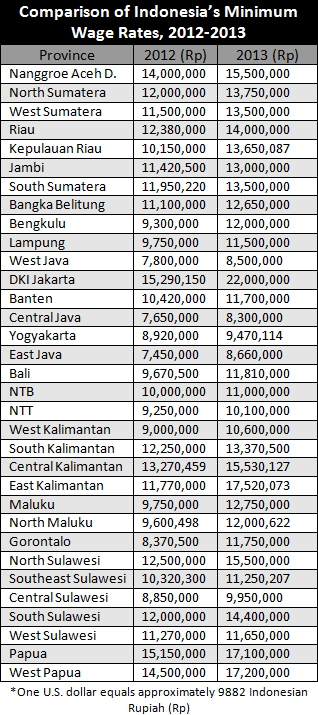ASEAN’s Rising Minimum Wage Levels: Indonesia
By Alex Tangkilisan
Jun. 18 – Several ASEAN countries have raised their minimum wage standards recently to align their average salary levels to the rising costs of living and to provide their citizens with higher purchasing power. However, businesses and investors have complained that the somewhat drastic wage hikes have hurt the market in terms of competitiveness and lowering worldwide interest in establishing a business presence in these countries – which would truly be a blow to an emerging ASEAN.
The ASEAN countries that have recently raised their minimum wage levels include Thailand, Vietnam, the Philippines, Malaysia and Indonesia. In this article we will discuss the recent minimum wage changes in Indonesia. In the coming weeks, ASEAN Briefing will also cover the changes to minimum wage levels in the aforementioned countries.
Indonesia
In Indonesia, there is only one general legislative standard for minimum wages throughout the country as stipulated under Articles 88, 89 and 90 of Act 13 of Indonesia’s Labor Law (2003). This law allows for the local governments to set their own minimum wage levels, meaning that there is no nationwide minimum wage standard.
Currently, minimum wage levels are set annually by each province’s governor or each district/city’s mayor with assistance from their respective Wage Councils. In addition, there exists a minimum wage standard that varies by sector or occupation within each province. This standard is determined by the respective province’s governor with assistance from various corporate organizations and worker/labor unions within the applicable sector. Generally, the minimum wage laws cover formal sector workers who work 40 hours per week at a rate of about seven to eight hours per day.
The governor of each province decides the minimum wage rates in their province based on recommendations and advice from the provincial-level Wage Council, while the mayor of each district/city determines the minimum wage levels in their district/city with help from the district-level Wage Council. The Wage Councils consist of governmental officials, entrepreneurs and representatives from various labor unions.
So, which wage rate is actually followed? Simply put, if an employee works in a certain district within a province, but that district does not have a minimum wage set yet, then they will be subject to receive the minimum wage amount set by the province. However, if the district in which they reside in has already enacted a minimum wage, then they will be paid that amount. Similarly, if someone is working in a certain sector within a certain district that already has a minimum wage standard for that sector, then they will be paid the sector minimum wage amount.
Why?
The Indonesian government’s decision to adjust its minimum wage standards stems from the country’s relatively prosperous GDP growth rates of over 6 percent annually over recent years. As a result of Indonesia’s growth, various labor groups throughout the country demanded larger, more sustainable wage levels to compensate. For comparison, Indonesia’s GDP is quadruple that of Singapore’s and Malaysia’s, and almost triple that of Thailand’s.
As a result, Indonesia’s average minimum wages have risen by a fairly sizeable amount, rising on average by 19.1 percent to Rp1.30 million (US$130) this year. This sharp increase has notably affected the capital city of Jakarta and popular tourist destination East Kalimantan the most, with their respective minimum wage amounts rising by 43.87 percent and 48.86 percent to Rp2.2 million (US$220; highest in the country) and Rp1.75 million (US$175). These are the largest reported minimum wage increases in over a decade. For comparison, in China the highest monthly minimum wage level is RMB 1,500 (US$245) per month in the city of Shenzhen, while in the Indian city of Delhi the minimum wage per month is INR8,112 (US$147).
The Cost of More
What once made Indonesia such an attractive investment opportunity is seemingly headed to become one of its weaknesses. Factories throughout the country have felt a negative impact from having to pay their workers an increased salary, and companies in Indonesia’s garment manufacturing capital of West Java have even reported declines in profits of up to 40 percent since they started paying their workers the higher wages.
Indonesia’s capital and most well-known city of Jakarta has suffered the most from the new wage rates, with close to 100 companies already planning to move out of Jakarta to more remote locations in Central Java (where labor costs are almost half as cheap). This has also sparked fears on the part of workers as factories close and move to other areas, paving the way for higher than usual unemployment rates in the country. Indonesia’s unemployment rates have decreased over the past few years from a high of 11.24 percent in 2005 to as low as 6.14 percent in 2012.
However, Indonesian law does allow for factories to apply to be excused from paying the minimum wage rates if they can prove that the hikes would hurt them financially. To obtain this exemption, the company will need to provide the Ministry of Industry and Trade with its financial books covering the previous two fiscal years to prove that its profits would take a large hit in addition to obtaining written consent from its factory workers. According to the Ministry of Manpower, 941 firms have already applied for this exemption, yet only 47 applications have been approved.

- Previous Article ASEAN Corporate Governance Scorecard
- Next Article China-ASEAN Expo To Strengthen Economic Ties









